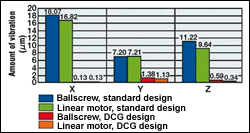Motor Type Vs. Machine Design
On a machining center, the choice of ballscrews or linear motors may not be as important as where the motors apply their force.
Do linear motors make a machining center better? Or, more specifically, do they improve dynamic stiffness? A study conducted by machine tool builder Mori Seiki suggests that the answer is yes, but with an important caveat. Applying linear motors alone is not necessarily the most effective way to improve stability. When it comes to dynamic stiffness, changing the machine design may offer more potential for improvement.
Mori Seiki managing director Kazuyuki Hiramoto supplied the data for the graph on the following page. The numbers represent the test results for trials run on a test machine with and without linear motors, and with and without a machine-tool design concept called “Driven at the Center of Gravity,” or DCG. What the numbers specifically measure is the amount of vibration that resulted after the machine was moved and stopped. The point of the comparison is that some vibration can be attributed to how the axis motors work, but potentially more of the vibration results from where the force of those motors is directed.
Axis motors on machining centers tend not to apply their force through the center of gravity of the moving elements, but instead they tend to apply it to one side or the other. Dr. Hiramoto says this runs contrary to a principle we all intuitively know. That is, when moving a heavy weight, we try to push at the center. The problem with not driving through the center of gravity on a machining center is that machine tools are—in a sense—squishy. Even a push by hand might deform a machine by 10 microns. The slight twisting of machine elements that comes from linear axis forces pushing off-center can cause vibration that may ultimately affect the surface quality of the part and the life of the tool. Machining center users sometimes deal with this vibration by making gradual starts and stops.
The company’s DCG machines do try to push through the center of gravity. The machines use ballscrews, and the very challenge in realizing the DCG concept is that the lines through the center of a machining center may not leave room for a ballscrew. The spindle occupies a central location on a machine, and so might a rotary table. In these cases where some other basic component of the machine interferes at the center, the DCG machine uses two ballscrews instead, one ballscrew on either side, so that the resultant force still does drive through the center.
Related Content
-
Twin Spindle Design Doubles Production of Small Parts
After experiencing process stalls in the finishing stage of production, Bryan Machine Service designed an air-powered twin spindle and indexable rotating base to effectively double its production of small parts.
-
Watchmaking: A Machinist’s View
Old-world craftsmanship combines with precision machining on a vertical machining center and Swiss-type lathe to produce some of the only U.S.-made mechanical wristwatch movements.
-
Volumetric Accuracy Is Key to Machining James Webb Telescope
To meet the extreme tolerance of the telescope’s beryllium mirrors, the manufacturer had to rely on stable horizontal machining centers with a high degree of consistency volumetric accuracy.

.jpg;width=70;height=70;mode=crop)






.jpg;maxWidth=300;quality=90)






